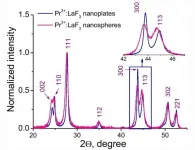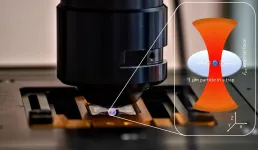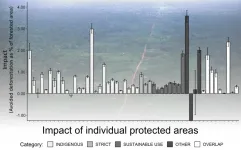(Press-News.org) From the vocal cords that produce our voice, to our heartbeat, our body's cells are constantly subjected to mechanical forces that steadily change their response to these stimuli, regulating vital processes, in healthy individuals and in diseases such as cancer alike. Nevertheless, despite their importance, we remain largely ignorant of how cells sense and respond to these forces.
Now, an international team co-led by the researcher Pere Roca-Cusachs, from the Institute for Bioengineering of Catalonia (IBEC), and Isaac Almendros, a researcher at the Respiratory Diseases Networking Biomedical Research Centre (CIBERES) and IDIBAPS, both professors at the Faculty of Medicine and Health Sciences of the University of Barcelona (UB), has proved that what determines mechanical sensitivity in cells is the rate at which the force is applied, in other words, how fast the force is applied. The paper has been published in the prestigious journal Nature Communications and shows, for the first time in vivo, the predictions of the "molecular clutch" model.
These results open the door to a better understanding of how a cancerous tumour proliferates, as well as how the heart, the vocal cords or the respiratory system respond to the constant variation of forces to which they are repeatedly exposed.
A constant cellular "push and pull":
The researchers observed that there are two responses to the force applied to a cell, using state-of-the-art techniques such as Atomic Force Microscopy (AFM) or so-called "optical tweezers".
On the one hand, the cytoskeleton, the dense network of fibres (mainly actin), which has, among others, the function of maintaining the shape and structure of the cell, is reinforced when the cell is subjected to a moderate force. In this regard, the cell is able to sense and respond to mechanical force, and the reinforcement of the cytoskeleton leads to a stiffening of the cell, and the localisation of the YAP protein in the nucleus. When this occurs, the YAP protein controls and activates genes related to cancer development.
On the other hand, if the rate of force applied is repeatedly applied above a certain value, a reverse effect occurs; the cell no longer senses the mechanical forces. In other words, instead of the cytoskeleton and the cell becoming more rigid, a partial breakdown of the cytoskeleton occurs, leading to a softening of the cell.
"Like stretching and shrinking chewing gum, we have subjected cells to different forces in a controlled and precise manner, and we have seen that the rate at which the force is applied is of the utmost importance in determining the cellular response", explains Ion Andreu (IBEC), co-lead author of the study.
A model corroborated by in vivo experiments:
To understand how the reinforcement and softening effects of the cytoskeleton are related, the researchers developed a computational model that considers the effect of the progressive application of force on the cytoskeleton and the "couplings" (proteins involved in binding the cell to the substrate, such as talin and integrin). These "couplings" are somewhat akin to the effect of the clutch of a car, in tightening the mechanical connection between the engine and the wheels, which is why the model is known as the "molecular clutch".
Next, the scientists performed experiments on laboratory rats to prove that the results observed in single cells also occur in in-vivo whole organs. To do so, the researchers studied the lungs, which naturally undergo cyclical mechanical stretching during breathing. Specifically, the two lungs were ventilated at different rates, with one lung filling and emptying faster (hyperventilation) and the other more slowly, while maintaining a normal total ventilation rate.
After analysing and comparing cells from both lungs, they observed that the YAP protein increased its nuclear localisation only in cells from the lung subjected to hyperventilation. This increase in YAP in in-vivo samples, caused by the "cellular tug-of-war", was akin to that found in proliferating cancer tumours.
"Our results demonstrate, at organ level, the role of force application rate in the transduction of the ventilation-induced mechanical signal in the lungs", states Bryan Falcones (IBEC-UB), co-lead author of the study.
The paper sets out a mechanism by which cells respond, not only to direct forces, but also to other passive mechanical stimuli, such as the stiffness of the substrate on which they are located. The results give an insight into understanding how a priori opposite phenomena, such as reinforcing and softening of the cytoskeleton, can go hand in hand with controlling cell mechanics and respond specifically to different situations.
INFORMATION:
The article represents the transmission electron microscopy (TEM) and flow cytometry study of A-549 (human lung carcinoma) cellular uptake of Pr3+:LaF3 nanoparticles. The Pr3+:LaF3 nanoparticles are promising platforms for cell nano-sensors.
The objective of the work was to study the influence of nanoparticle morphology (nanoplates and nanospheres) on cytotoxicity and the dynamic of cellular uptake.
In the flow cytometry method, the cells go through a small tube (as a flow) and are irradiated by a laser. Cells scatter the laser light, and this scattering ...
Measurements of biomechanical properties inside living cells require minimally invasive methods. Optical tweezers are particularly attractive as a tool. It uses the momentum of light to trap and manipulate micro- or nanoscale particles. A team of researchers led by Prof. Dr. Cornelia Denz from the University of Münster (Germany) has now developed a simplified method to perform the necessary calibration of the optical tweezers in the system under investigation. Scientists from the University of Pavia in Italy were also involved. The results of the study have been published in the journal Scientific Reports.
The calibration ensures that measurements of different samples and with different devices are comparable. ...
The ability to predict and interpret modifications of ribonucleic acid (RNA) has been a welcome advance in biochemistry research.
However, existing predictive approaches have a key drawback--they can only predict a single type of RNA modification without supporting multiple types or providing insightful interpretation of their prediction results.
Researchers from Xi'an Jiaotong-Liverpool University, led by Dr Jia Meng, have addressed this issue by developing a model that supports 12 RNA modification types, greatly expanding RNA research prediction and interpretation.
"To the best of our knowledge, ...
While tropical forests remain threatened and their future is uncertain, the importance of understanding how well individual protected areas avoid deforestation increases. Researchers from the University of Turku and University of Helsinki, Finland, have investigated this question in a newly published study that focuses on the State of Acre in Brazilian Amazonia.
Tropical forests are unique environments that have huge species diversity and also act as important reservoirs of organic carbon, thereby counteracting climate change. However, their area is diminishing due to deforestation, ...
Tsukuba, Japan - A team of scientists led by Associate Professor Haruka Ozaki of the Center for Artificial Intelligence Research at the University of Tsukuba in collaboration with Dr. Koichi Takahashi from RIKEN used mathematical algorithms to optimize the schedule of automated biology laboratory robots. By analyzing the needs of time-sensitive samples that require investigation using multiple instruments, the researchers were able to maximize the number of experiments that can be performed within time and laboratory resource constraints. This work may help in the design of future automated biology labs and other workspaces.
Biology laboratories have seen increasing automation because many tasks, like pipetting solutions or moving cells from one ...
CAMBRIDGE, MA -- Most of the tests that doctors use to diagnose cancer -- such as mammography, colonoscopy, and CT scans -- are based on imaging. More recently, researchers have also developed molecular diagnostics that can detect specific cancer-associated molecules that circulate in bodily fluids like blood or urine.
MIT engineers have now created a new diagnostic nanoparticle that combines both of these features: It can reveal the presence of cancerous proteins through a urine test, and it functions as an imaging agent, pinpointing the tumor location. In principle, this diagnostic could be used to detect cancer anywhere in the body, including tumors that have metastasized from their original locations.
"This is a really broad sensor intended to respond to both primary tumors and their ...
Reno, Nev. (July 15, 2021) - Wildfire smoke may greatly increase susceptibility to SARS-CoV-2, the virus that causes COVID-19, according to new research from the Center for Genomic Medicine at the Desert Research Institute (DRI), Washoe County Health District (WCHD), and Renown Health (Renown) in Reno, Nev.
In a study published earlier this week in the Journal of Exposure Science and Environmental Epidemiology, the DRI-led research team set out to examine whether smoke from 2020 wildfires in the Western U.S. was associated with an increase in SARS-CoV-2 infections in Reno.
To ...
A new study by Vanderbilt University Medical Center researchers of more the 400,000 Medicare patients taking medications for insomnia found that the risk of death is increased when either benzodiazepines or "z-drugs" are taken with opioids.
The study, published July 15 in PLOS Medicine and led by Wayne Ray, PhD, professor of Health Policy at VUMC, compared patients taking these drugs with opioids to comparable patients taking trazodone, another commonly prescribed sleep medication for older patients.
The researchers found that those using benzodiazepines had a 221% increase in the risk of death from ...
LA JOLLA, CALIF. - July 16, 2021 - An international research group, led by Jamey Marth, Ph.D., a professor at Sanford Burnham Prebys, has shown that the Neuraminidase 3 (Neu3) enzyme is responsible for the onset and progression of colitis--a chronic digestive disease caused by inflammation of the colon. The study, recently published in the Proceedings of the National Academy of Sciences, was performed in a model of recurrent human food poisoning previously linked with the condition. The findings represent a scientific advance toward a targeted therapy to help the millions of people worldwide affected by the disorder.
"Our new research demonstrates how increased activity of ...
Increases in maternal opioid use have led to an almost doubling in the number of babies born with neonatal abstinence syndrome (NAS) in the U.S. in the past 10 years. This statistic led the Centers for Disease Control and Prevention and American Academy of Pediatrics to call for stepped-up efforts to reduce opioid use during pregnancy, such as ensuring access to contraception to prevent unintended pregnancies among women who use opioids. More than 75% of women with Opioid Use Disorder (OUD) report having had an unintended pregnancy, but they are less likely to use effective ...





